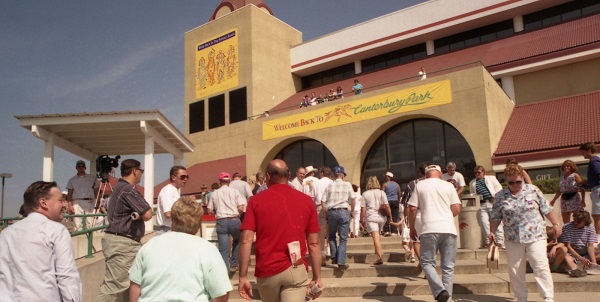BY JIM WELLS
It was the year of the O.J. Simpson trial and the Oklahoma City bombing. Michael Jordan came out of retirement and rejoined the Chicago Bulls, and Major League baseball players waged a 232-day strike. The e-bay shopping website arrived and the Grateful Dead broke up.
Oh…..and Dave Van Winkle won the training title at Canterbury Park, the resurrection of what had been Canterbury Downs.
That achievement escaped him when asked recently what he recalled about the summer of 1995. The years run into one another as they accumulate for many of us; the past becomes a kaleidoscope of events that are difficult to pin at times to this year or that one.
“I know I won three of them, just not the years,” he said. “It’s too long ago.”
Van Winkle is not alone in that sentiment. There were doubts at the time that racing would make it on its third try, much last celebrate its 25th anniversary. Yet that is precisely what will happen throughout the upcoming meet in Shakopee, starting on opening night Friday and continuing with Saturday’s card that includes simulcast wagering on the Kentucky Derby.
The summer of 1995 provided a new opportunity, a fresh start for thoroughbred and quarter horse owners and racing itself, for the men and women who had invested their futures in those industries before and after the glistening new track had opened in 1985, only to close in 1992.
It’s been a quarter of a century since the appellation “Park” replaced the “Downs,” when horsemen celebrated as men of their own ilk replaced the previous owners, decried as betting shop purveyors who considered the promotion of live racing anathema to their business interests.
The name Sampson replaced that of Ladbroke, the British corporation that purchased the track in 1990 but produced only steep declines in attendance and wagering. Gopher State horsemen rejoiced; validated for the daring stand they took against Ladbroke, whose intent they believed was to turn Canterbury into a glorified version of its European betting shops. The Minnesota Racing Commission, at the behest of horsemen, denied a license renewal to Ladbroke, forcing it out of business in Shakopee and opening an uncertain path for the state’s breeders and owners.
There were numerous questions at the time. Who had the money to buy the track, re-open and operate it at a profit or even on a break-even basis after the first two owners failed?
Third time’s the charm became the operative cliché, yet it was indeed.
Financier Irwin Jacobs had the money to buy Canterbury and he did, in 1993. But he didn’t want to run a racetrack. He didn’t even want to own one, not for long at any rate. He sold it three months later at a fraction of its original cost and subsequent improvements (a total of $70 million was the figure quoted most frequently at the time), yet at a small profit for himself. The buyer who stood up was Curtis Sampson, with minority partner Dale Schenian. In 1994, Canterbury Park Holding Corporation was formed and an initial public offering raised $8 million. The racetrack with the huge original loan in 1985 and beyond was essentially debt free.
Trainer Jerry Livingston was at Canterbury the first year it offered quarter horse racing (1986) and returned each meet until it closed.
“I always thought it would open again,” he said. “I just didn’t know when.”
Livingston experienced the very same feelings that gripped other horsemen during the shutdown. “There was a void without it,” he recalled.
Canterbury was about to make an even more favorable impression than it had originally under the guidance of Santa Anita personnel along with Brooks Fields and certainly under the second owner, Ladbroke.
“It was always so welcome to horsemen, which is quite unusual,” Livingston said. “Then we got these owners (Curt Sampson and Dale Schenian) and it’s been grand,” he added (as it had been under Fields and Santa Anita). “I hope they have a heck of a year.”
Trainer Joe Merrick was in Shakopee for meets during the Santa Anita years and at times since, as recently as last summer. He was delighted to see the change of ownership after the Ladbroke years.
“We enjoyed those years,” he said. “It was good to see people who were horsemen directing the show and making decisions that weren’t merely corporate.”
New ownership brought a change as well in the way Merrick referred to the “new” place. “I had to get used to calling it Canterbury Park instead of Downs,” he said.
Hall of Fame trainer Bernell Rhone has not missed a meet at Canterbury Downs or Park and is back for the 2019 meet. He was on hand during the tumultuous years and the recovery, and is well versed in track history.
“We did the right thing by forcing Ladbroke out,” he said. “Then, when Jacobs bought it, we had no idea what was going to happen. When he sold it to the Sampsons, we knew that they were interested in horse racing, that it was going to reopen, that they were going to run it as a racetrack.”
What had been a $75 million franchise went for $5 million the third time around, and that, too, was a huge factor in what has transpired in the years since. “Well, yes, they did get it at a much better price and that helps tremendously,” Rhone added.
In the 25 years since, Canterbury Park has replaced the Downs despite all the uncertainty at the time. It has created a separate recognition, an identity of its own.
I agree,” Rhone added. “They have truly made their own mark. It is not Canterbury Downs, but simply Canterbury Park.”
That fact will be celebrated throughout the upcoming meet.
